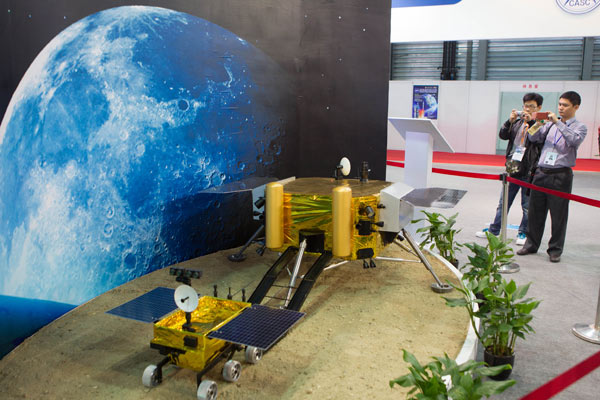

A model of the Chang'e-3 lunar rover is on display at an exposition in Shanghai this month. Wu Zhijian, spokesman for the State Administration of Science, Technology and Industry for National Defense, said at a news conference on Tuesday that the Chang-e' 3 lunar probe will be launched in early December. The soft lunar landing will be the first by any country in 37 years. Gao Erqiang / China Daily
Chinese scientists have built an experimental landing site in Beijing to test the functions of the lander, and they have simulated moon-surface locomotion of the rover, Li said.
"We have conducted large numbers of tests in each stage to avoid perils, and have contingency plans based on these tests, ... but after all, it's our soft-landing on the moon, so there are certain risks."
At the news conference, Li congratulated India on its recent successful launch of a mission to Mars — its first. He said China is not competing with any other country, but it is interested in peaceful advancements.
Pang Zhihao, executive editor-in-chief of the monthly publication Space International, said China's lunar rover must overcome many dangers and difficulties for it to "survive and operate" after landing in Sinus Iridum, or the Bay of Rainbows, on the moon's surface.
The moon's wide temperature range — from more than 100 C during the day to as low as -150 C at night — presents just one of many challenges. To work properly, the rover needs to maintain an internal operating temperature range of -40 to 50 C, Pang said.
"The temperature-control system is crucial for the operation of the solar-powered rover," he said.
In fact, nuclear power will be used during the night to maintain the rover's temperature in the correct range, he said.
Wang Ya'nan, deputy editor-in-chief at Aerospace Knowledge magazine, was enthusiastic.
"The Chang'e-3 mission will definitely become one of the most important and magnificent events in humanity's exploration of the moon since the United States landed its astronauts more than 40 years ago," Wang said.
Wu Yanqin, a professor of astronomy at the University of Toronto, said the new mission was a big step beyond the orbiters China has sent to circle the moon.
"I am impressed with the fact that this mission is equipped with a telescope to observe the sky. This is remarkable given the many other technical hurdles that had to be overcome. If the telescope can successfully operate, it will be a world record," Wu said.
Abraham Loeb, chair of the Astronomy Department at Harvard University, said the landing site for China's Chang'e-3 moon lander is in the vicinity of the Laplace A crater, which measures 8 km in diameter. In the distant past, material ejected from deep in the crater ended up near the crater's rim and can tell a story about the moon's composition.
The rover, equipped with four cameras, will patrol the surface for at least three months. If it explores the edge of the crater, it will identify material that originated deep below the surface and provide new clues about the moon's history, Loeb said.
"The lander will open a new age in space exploration by China," he said.
Copyright ©1999-2018
Chinanews.com. All rights reserved.
Reproduction in whole or in part without permission is prohibited.